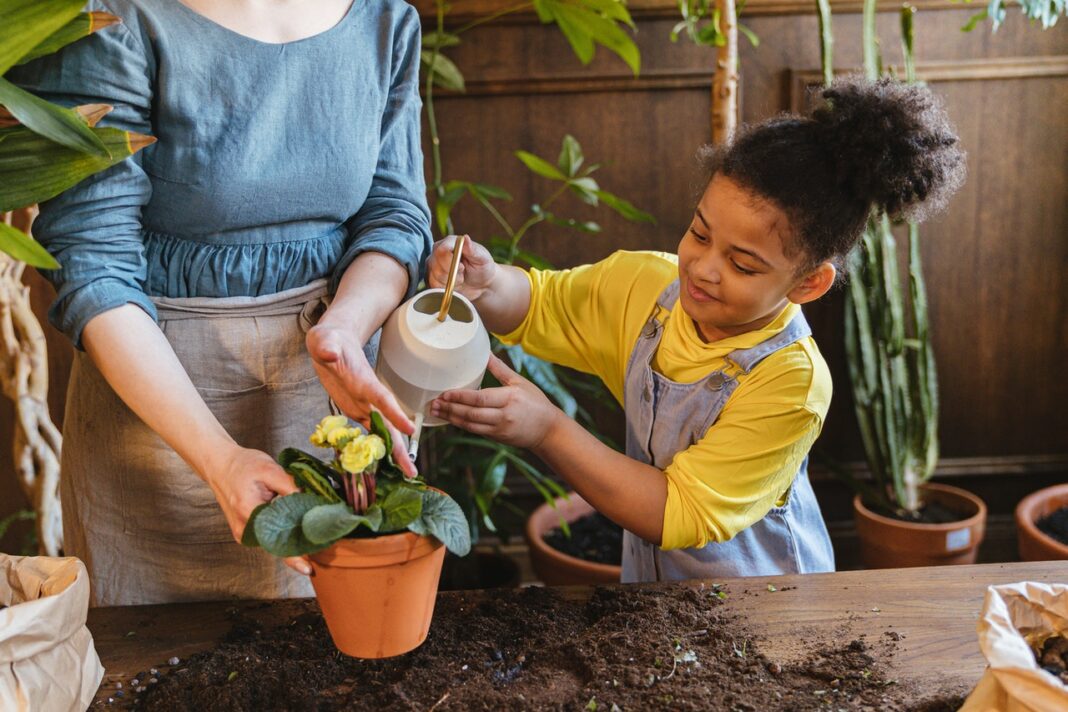Outdoor activities are always fun and healthy. Gardening is one such hobby that provides children with the opportunity to learn life lessons from nature and develop essential skills. Keep reading to know about the benefits of gardening for your children.
Benefits Of Gardening For Children
1. Exercise
Gardening provides both mental and physical exercise to children. Activities like digging, raking, carrying, lifting, and watering require strength and use a number of muscles in the body. By spending some time in the garden, children can get moderate physical exercise and develop their motor skills. This will also reduce the screen time for children.
2. Sensory introduction and development
Children can explore all their senses in the garden. They will learn about flowers, fruits, and vegetables by touching, smelling, and even tasting them. They can also feel the texture of dirt and discover the smell of wet grass.
3. Patience
Gardening rewards hard work, patience, and determination. It can take days, weeks, and even months for plants to flower and bear fruits. The long wait creates excitement, and children will learn to be patient.
4. Responsibility
Plants return the love and attention shown to them with beautiful blossoms and delicious fruits. Growing plants does not come naturally to us except for some with green thumbs. If your kid wants to give gardening a try, remember that the first few plants might be a failure. It will be a lesson for them to be responsible for taking proper care of their plants.
Related: Top 10 Benefits of Growing Up With a Pet
5. Healthy eating
Many kids are picky eaters and dislike certain fruits and vegetables. When they grow and pick fresh fruits and vegetables from the kitchen garden, it instills a sense of accomplishment. They are likely to take pride in consuming healthy food that they have grown.
6. Learning
The garden can be a classroom for your child, where nature is the teacher. Gardening is a great way to teach concepts and processes like germination, sprouting, budding, and reproduction. They learn about how plants need water, soil, nutrients and sunlight to grow. In addition to that, they also learn about different insects, seasons, weather, and various species of plants.
7. Family bonding
You can bond with your child by encouraging them to participate in gardening activities. It can be a break from the busy schedule for relaxing family time. So, invest in quality gardening tools including weeder, trowel, hand fork, cultivator, scissors, pruners, garden shears, watering cans, etc. To buy gardening tools kit for home garden, click here. Also invest in some designer planters to beautify and decorate your garden and indoors.
Recommended reading: 5 Tips to Stop Being an Absent Parent
8. Immune system
Health benefits of gardening cannot be undermined. Digging in the soil is fun for many young children. Soil is rich in microbes that help in strengthening the immune system. It reduces the risk of developing certain allergies and asthma.
9. Environmental awareness
Gardening nurtures the love for plants and nature. Children who like gardening recognize the labor of growing plants and learn about their importance. They are more likely to become responsible adults who care for the environment.
Recommended reading: Books for a Better Planet! 20 Earth-Friendly Reads for Kids
10. Stress relief
Besides being a productive hobby, gardening helps children relax and be calm. It provides them the opportunity to be free from gadgets for a while and enjoy a peaceful time in nature.
FAQs On Gardening For Children
1. What are the skills learned from gardening?
Gardening is an educational pastime that helps in the overall development of children. Here are some skills that children can learn from gardening.
Locomotor skills. Spending a generous amount of time in the garden can help develop locomotor skills in young children like walking, running, hopping, and climbing.
Fine motor skills. A child can practice fine motor skills while holding the sprinkler, moving flower pots, and poking seeds into the soil.
Cognitive development. Children can develop their cognitive skills like remembering, analyzing, storing, and retrieving information in the garden where they learn to identify different plants.
Literacy skills. A garden is the best place for your child to learn the names of different plants, flowers, and insects.
Creativity. The garden provides a child with the opportunity to be creative. Activities like selecting plants to grow, coloring flower pots, and playing with dirt allow them to explore their imagination.
Life skills. A garden can teach valuable life skills to children. It instills a sense of diligence, patience, and responsibility.
2. What are some gardening activities for toddlers?
Engage your little one in these fun garden activities.
Watering the plants. Watering the plants is one of the easiest tasks you can assign to young children.
Pulling the cart. Get a mini trolley for your little one to pull around while you take care of yard work.
Raking leaves. Another simple garden assignment for your tot is to rake leaves. Be sure to have child-friendly tools.
Shoveling. Kids love playing in the dirt. They’ll happily scoop up a spot for you in the garden on request.
Weeding. Children can help you to get rid of unwanted plants in your yard.
Planting seeds. Your little one can experiment with growing plants on their own.
Decorating the garden. Encourage children to add a personal touch to their plants with colored stones, sticks, and labels.
Harvest. Make harvest time fun for your children. Teach them how to pick different veggies and fruits.
Eating. Share the joy of growing your food with your child as you let them relish the fruits from your kitchen garden.
3. How do you teach plants to preschoolers?
Here are some ideas for teaching toddlers about plants.
Stimulate the curiosity of your child by showing them different kinds of plants.
Play with plants. There are many ways kids play with plants. They build tiny houses with sticks, pretend to eat leaves, and make flower crowns and rings. Playing with plants brings them closer to nature.
Plan fun activities. Spending time outdoors has several benefits. One of them is the opportunity to observe and learn about nature. Go camping or take a stroll in the park to enjoy nature and help your tot identify trees and plants. They will soon begin to notice the different shapes and colors of leaves, flowers, and fruits.
Read books. Using picture books to teach about plants from different regions and climates is another good idea. You can also use books to teach about parts of plants.
Together time. Allow your child to accompany you while gardening for a lesson in the world of plants. They will also learn about soil, water, and sunlight.
Recommended reading: Practical Tips To Teach Your Child About Sustainable Living
4. How do you explain garden to a child?
A garden is an area near a house where flowers, herbs, trees, and different plants are grown. If you want to explain gardening to a child, how do you do it? Here are some tips for teaching children about gardens.
Take a garden tour. The first step is to show what a garden looks like. Let your child explore the outdoor patio.
Invite them to join you when gardening. Your child can learn a lot about gardening by watching you plant seeds, pull weeds, water plants, etc. They begin to understand how plants grow in a garden.
Eat from your garden. The greatest blessing of gardening is the harvest. Share the joy of growing your food with them. Prepare dinner with fresh produce from your home-grown vegetable patch.
Visit a farm. As your child learns where their food comes from, they will be more likely to value them in the future.
5. How do you introduce a garden?
The following are some ideas for introducing a garden to your little one.
Spend time in your garden. Children learn well and understand the world through play. Letting them play in your garden will eventually lead them to notice the plants. Begin by showing them a garden – a vegetable patch or a yard adorned with flowers.
Start a simple project. Grow a plant in a cup to let your child observe its growth process. Watching flowers bloom and plants bear fruit will be a magical experience for young kids. Additionally, it will teach them how dirt, sunlight, and water help to grow plants.
Ask them if they want to lend you a helping hand. When your kid expresses an interest in gardening, be sure to encourage them to pursue this healthy activity. For beginners, assign simple tasks like watering the plants and helping you pull the cart. Teach them how to rake leaves and remove weeds.
6. How do you encourage children to garden?
Here are a few ways to develop your child’s interest in gardening.
Give them the option of choosing the plants. Explore the nursery with your child. Allow them to pick what they want to grow.
Make sure the garden is easy to access. Let your child explore your garden independently (under your supervision). Place labels and stepping stones to make navigation easier.
Bring the garden indoors. The best way to foster your child’s interest is by getting them a garden of their own. Pick a sunny spot inside the house to place the planter. Give them a hands-on experience with maintenance. It’s their garden, so let them be responsible for its well-being.
Add it to their daily routine. Make it a habit to check the growth process and record it. Observing changes in plants and watching their growth will be fascinating and motivating for them.
Don’t forget to have fun. Gardening is a fun activity. Hold your child’s interest by making it exciting.
Conclusion: Benefits of Gardening For Children
Watching your garden grow, bloom, and provide fruits and vegetables that end up on your plate is delightful and rewarding. Given the benefits of gardening for children, give your child the joy of growing their garden.




